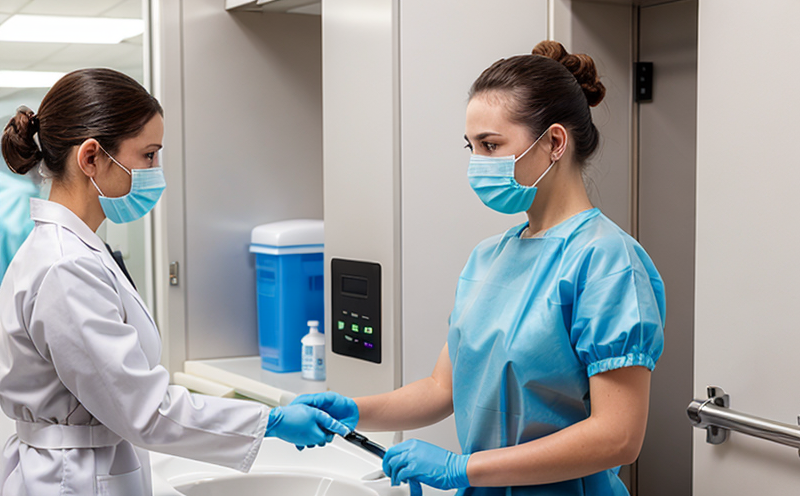ISO 13629-2 Antimicrobial textile testing Transfer method
The ISO 13629-2 standard provides a robust framework for evaluating the antimicrobial efficacy of textiles using the transfer method. This approach focuses on assessing how effectively an antimicrobial agent can prevent microorganisms from transferring onto or between surfaces after contact with the treated fabric.
Textiles are integral to many sectors, including healthcare, food processing, and personal care products, where hygiene is paramount. Ensuring that textiles maintain their antimicrobial properties over time is crucial for protecting users against infection risks. The ISO 13629-2 standard helps manufacturers validate the performance of their products, ensuring they meet stringent quality standards set by international authorities.
The transfer method involves placing a textile sample and a test organism in close proximity to each other under controlled conditions. After an incubation period, the sample is examined for microbial growth or transfer onto another surface. This process allows for precise evaluation of the antimicrobial properties of the fabric without exposing it directly to pathogens.
The testing procedure outlined in ISO 13629-2 ensures that textile manufacturers can demonstrate compliance with regulatory requirements and industry best practices. It offers a reliable means of assessing antimicrobial performance, which is critical for maintaining hygiene standards across various applications.
Understanding the nuances of this standard helps stakeholders appreciate its importance in safeguarding public health. By adhering to ISO 13629-2, businesses can enhance their reputation as leaders in innovation and quality assurance within the textile industry.
- Microbial Challenges: The transfer method effectively addresses concerns about cross-contamination between textiles used in critical environments like hospitals or food processing plants.
- Consistent Results: Standardized protocols ensure consistent and reproducible results across different laboratories, enhancing credibility and reliability of the test outcomes.
- Regulatory Compliance: Adherence to international standards is essential for meeting regulatory requirements imposed by governments worldwide.
- User Safety: By ensuring textiles maintain their antimicrobial properties, this method contributes significantly to user safety, especially in sectors where hygiene is critical.
The ISO 13629-2 standard plays a vital role in the textile industry, providing a standardized approach to evaluating antimicrobial efficacy. This ensures that products meet rigorous standards, thereby enhancing confidence among consumers and stakeholders alike.
Implementing this testing protocol helps manufacturers stay ahead of market trends by demonstrating their commitment to quality and safety. It also provides valuable insights into product performance under real-world conditions, enabling continuous improvement in product development cycles.
Why Choose This Test?
The ISO 13629-2 antimicrobial textile testing transfer method offers several advantages over other methods. Firstly, it allows for the assessment of microbial transfer onto surfaces in real-world scenarios, which is more relevant than direct contact tests.
- Realistic Assessment: The method simulates actual conditions under which textiles are used, providing a more accurate reflection of their performance.
- Comprehensive Evaluation: It evaluates not only the antimicrobial properties but also the durability and effectiveness over time.
- Rigorous Standards: Compliance with international standards ensures that results are reliable and widely accepted across different markets.
The test is particularly beneficial for manufacturers looking to improve hygiene in products used in sensitive environments. By choosing this method, businesses can ensure their textiles meet stringent quality benchmarks, thereby enhancing consumer trust and satisfaction.
In summary, the ISO 13629-2 transfer method offers a comprehensive approach to assessing antimicrobial efficacy, making it an invaluable tool for textile manufacturers aiming to enhance product performance and compliance.
Customer Impact and Satisfaction
The ISO 13629-2 transfer method significantly impacts customer satisfaction by addressing key concerns related to hygiene and safety. For instance, consumers in the healthcare sector value products that minimize cross-contamination risks, which this testing protocol directly addresses.
By ensuring textiles maintain their antimicrobial properties over time, manufacturers can deliver products that consistently meet or exceed expectations. This enhances brand reputation and customer loyalty, as satisfied customers are more likely to recommend the product to others.
In addition to immediate user benefits, long-term satisfaction is also enhanced through continuous quality assurance processes. Regular testing using ISO 13629-2 ensures that any potential issues with antimicrobial performance are identified early, allowing for timely corrective actions.
For businesses operating in competitive markets, maintaining high standards of hygiene and safety is crucial. The ISO 13629-2 transfer method provides a consistent means to achieve these goals, thereby contributing to overall customer satisfaction and brand reputation.
Competitive Advantage and Market Impact
The ISO 13629-2 transfer method provides a significant competitive advantage by offering a reliable and standardized approach to antimicrobial testing. This ensures that products meet the highest quality standards, setting them apart from competitors who may not adhere to such rigorous protocols.
By demonstrating compliance with international standards, businesses can confidently market their textiles as top-tier hygienic solutions. This enhances brand perception and attracts customers seeking reliable product performance in critical applications like healthcare or food processing.
The method also supports continuous improvement initiatives within manufacturing processes. Regular testing using ISO 13629-2 helps identify areas for enhancement, ensuring products remain at the forefront of innovation and quality.
In a crowded market landscape, standing out requires more than just good marketing; it necessitates tangible evidence of product performance. The ISO 13629-2 transfer method provides precisely this – verifiable data that can be used to differentiate offerings effectively.
Moreover, compliance with international standards is often a prerequisite for entry into certain markets or industries. By incorporating ISO 13629-2 testing into their quality control procedures, businesses ensure they are well-positioned to meet these requirements and expand their market reach.





